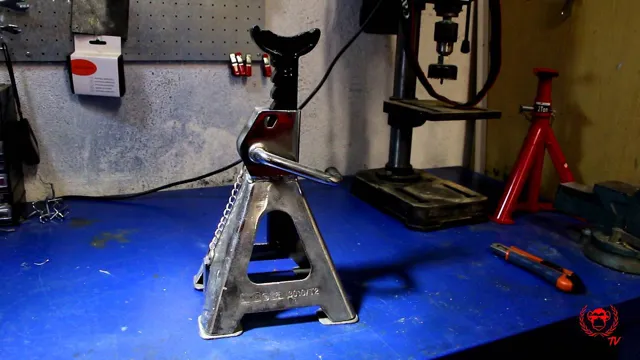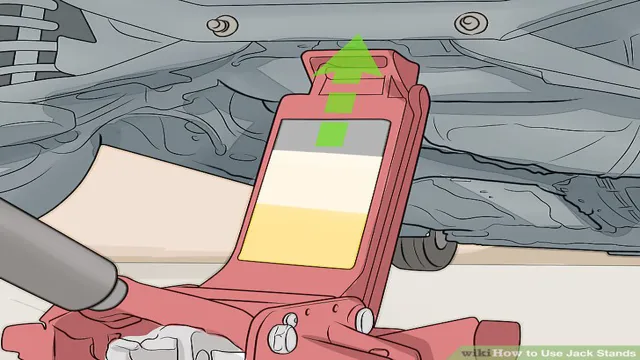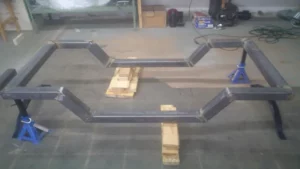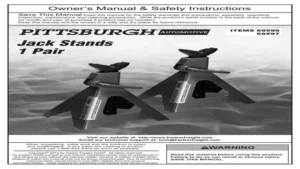Have you ever had to change a tire or perform maintenance work on your vehicle? If so, you know the importance of using jack stands for safety. Placing jack stands properly is crucial to avoid accidents and keep yourself and others safe. Think of jack stands as the sturdy foundation of your vehicle while it’s in the air.
Just like a house needs a solid foundation to stand still, your car needs a secure base to prevent it from toppling over. In this blog, we’ll go over the steps to properly place jack stands and keep yourself safe while working on your vehicle.
What You’ll Need
If you’re planning to do some repairs or maintenance work on your vehicle, placing jack stands is an essential task that should be done properly to ensure your safety. When working under your car, it’s important to use jack stands to prevent accidents or injuries if the vehicle falls off the jack. To begin, you’ll need a car jack and a set of jack stands.
A hydraulic jack is often the most popular choice, but you can also use a scissor or bottle jack as long as it can raise your vehicle off the ground. You’ll also need to have a solid and stable surface to work on, like a concrete garage or driveway. Remember to use the appropriate size and weight rating for your car, jack stands that are too small or weak can cause the vehicle to collapse and can be very dangerous.
Once you have everything you need, you’re ready to learn how to properly place jack stands.
Jack Stands
When it comes to working on your car, safety is absolutely critical. That’s where jack stands come in – these simple but essential tools can literally be lifesavers, preventing your car from falling on you while you work underneath it. To use jack stands, you’ll need a few basic things.
Obviously, you’ll need a set of jack stands themselves. It’s important to choose high-quality, reliable stands that are rated to hold the weight of your vehicle safely. You’ll also need a good quality jack to lift your car off the ground, and enough space to work safely.
Finally, make sure to wear appropriate clothing and safety gear, including gloves and eye protection. With the right tools and precautions, you can work on your car safely and confidently – and jack stands are an essential part of any toolkit!

Safety Glasses
Safety glasses are an essential piece of equipment for anyone working in hazardous environments. Whether you’re working in construction, manufacturing, or any other industry with potential safety risks, you’ll need a pair of safety glasses to protect your eyes. Choosing the right safety glasses can be daunting, but with a little knowledge, you’ll know exactly what you need.
Firstly, it’s essential to choose glasses that are appropriate for the task at hand, for instance, welding or metal fabrication may require protective lenses with a dark shade. Secondly, ensure that the glasses fit properly and securely on your face. Ill-fitting glasses provide less coverage and may be uncomfortable to wear for extended periods.
Lastly, check for the ANSI Z81 certification, which guarantees the glasses meet the required safety standards. Remember, eye injuries can be severe, and taking proper safety precautions will not only ensure your safety but also guarantee your productivity and efficiency on the job.
Wheel Chocks
Wheel chocks are an essential tool for keeping your vehicle in place. Whether you’re changing a tire, performing maintenance, or simply parking on an incline, the right set of wheel chocks can prevent unexpected movement and ensure your safety. So, what do you need to get started? First off, you’ll want to invest in a high-quality pair of wheel chocks.
Look for options made from durable materials like rubber or metal, with a high-grip surface to prevent slipping. Additionally, you may want to consider a chock holder or storage bracket to keep your chocks organized and easy to access. When using your chocks, make sure to position them snugly against the tires and double-check that your vehicle is secure before starting any work.
By taking the time to use wheel chocks properly, you can avoid potential accidents and keep yourself and your vehicle safe on the road. So why wait? Start shopping for wheel chocks today and enjoy the peace of mind that comes with knowing you’re prepared for anything.
Preparing Your Vehicle
When it comes to working on your vehicle, safety is of utmost importance. One essential aspect of safety is properly using jack stands to hold up your vehicle while you work underneath it. Before placing your car on jack stands, you should first park it on a flat surface and engage the handbrake.
You should also ensure that the transmission is in gear (manual) or in park (automatic). Once your vehicle is in place, locate the designated jack points on your car and position the jack stands directly beneath them. Make sure the stands are resting on a sturdy surface and that the locking mechanism is securely engaged.
Finally, test the stability of the vehicle by gently pushing on it before climbing underneath. By properly placing jack stands, you will be able to work on your car with peace of mind, knowing that you have taken the necessary precautions to keep yourself safe.
Choosing a Level Ground
Choosing a level ground is an important step in preparing your vehicle for any parking situation. It is crucial to find a level surface to ensure that your vehicle stays secure and stable. Uneven or sloped surfaces can cause damage to your tires and suspension, as well as increase the risk of accidents.
So, before you park your vehicle, take a moment to assess the ground beneath it. Look for any signs of unevenness or slopes and try to find a level spot. If there are no level surfaces available, use blocks or other tools to even out the ground and make sure your vehicle is secure.
Choosing a level ground is a simple but important step in keeping your vehicle safe and in good condition.
Engaging the Emergency Brake
Preparing your vehicle for emergency situations is crucial, and one of the most important steps is engaging the emergency brake. This brake is designed to prevent your car from rolling when parked, but it can be an essential tool in emergency situations. To prepare your vehicle, you should first locate the emergency brake on your dashboard or center console.
Ensure that the brake is functioning correctly by testing it in a safe area. If the emergency brake has not been used in a while, it may require some extra force to engage it fully. Remember to engage the brake whenever you park on an incline or when the car is not in use.
Practicing this simple step can prevent accidents and ultimately save lives.
Placing the Wheel Chocks
Before placing the wheel chocks, it’s crucial to prepare your vehicle. Start by turning off the engine and engaging the parking brake. If you have a manual transmission, put it in first gear or reverse before turning off the engine.
Next, assess the surface of the ground where you plan to place the chocks. Ensure that the surface is level and not slippery. If the ground is unstable or sloped, use additional safety measures such as placing blocks under the tires or using jack stands.
It’s also crucial to check the tire pressure and confirm that the vehicles are not overloaded beyond their weight limits. by taking these precautions, you’re ensuring that your vehicle is stable before placing the wheel chocks. This way, you can guarantee your safety as well as the safety of your passengers and anyone else nearby.
Placing Your Jack Stands
One of the most crucial aspects of car maintenance is knowing how to properly place jack stands. To begin, ensure that your vehicle is parked on a flat, level surface, and that the emergency brake is engaged. Locate the manufacturer’s recommended jacking points, typically found in the owner’s manual or on the label located near the car jack.
Make sure to align your jack stands with these points to safely support the weight of your vehicle. When placing the jack stands, test them by giving the vehicle a gentle push to ensure they are secure. Once the jack stands are in place, slowly lower the vehicle onto them and remove the jack.
Remember, never work under your vehicle without jack stands in place, as this can lead to serious injury or even death. By following these simple steps, you can rest assured that you are safely and properly supporting your vehicle during maintenance.
Locating the Jack Points
Locating the Jack Points and Placing Your Jack Stands Locating the jack points in your vehicle is essential before placing your jack stands. It’s important to know where to put them to ensure that your car doesn’t move or tip over while being lifted. Typically, the jack points are indicated in your car’s manual or on the chassis of the vehicle.
Few cars have a jack point near the wheels, while others have them near the front or rear subframes. Once you locate them, make sure they are clean and free from dirt and rust. Afterward, set your jack stands evenly on level ground and adjust their height to meet the jack points.
Remember, never attempt to place the jack stands under any part of the car that cannot support the weight. Doing so will only result in damaged suspension, braking, and cooling systems. Placing your jack stands correctly is one of the most important parts of lifting your car.
To avoid unnecessary accidents, ensure that they are secure and won’t move while working under your vehicle.
Using the Jack to Lift the Vehicle
When it comes to using a jack to lift your vehicle, it’s important to understand how to properly place your jack stands. First, make sure you’re on a flat and stable surface. Then, locate the designated jacking points under your car.
These are usually located along the frame rails or suspension components. Place the jack under one of these points and begin lifting the car until it’s high enough to place the jack stand securely in place. Repeat this process on the other side of the car.
It’s important to always use two jack stands and to never rely solely on the jack to hold up the vehicle. And remember, safety should always be your top priority when working on your car.
Positioning the Jack Stands
When it comes to placing your jack stands, there are a few critical things to keep in mind. First and foremost, safety should always be your top priority. Make sure that you’re using high-quality jack stands that are capable of supporting the weight of your vehicle.
Additionally, you’ll want to choose a level surface to work on. This will help to ensure that your car remains stable and reducing the risk of it rolling or shifting while you’re under it. When positioning the jack stands, make sure that they’re placed securely in the designated jack points under the vehicle.
It may be helpful to have a friend assist you with this step to ensure that everything is lined up properly. Finally, double-check that the jack stands are level and that they’re not leaning in any direction. With these steps in mind, you can feel confident knowing that you’ve positioned your jack stands safely and securely, allowing you to work on your vehicle with ease.
Lowering the Vehicle onto the Jack Stands
When it comes to working under your car, one of the most crucial steps is placing the jack stands properly. These stands have to be placed in the right location to ensure your safety and the stability of the vehicle. To do this, start by checking your owner’s manual to locate the recommended jacking points.
With that information, position the jack stand under the appropriate spot and slowly lower the car onto it. Make sure the stand is securely in place before releasing the jack. It’s also important to use jack stands rated for the weight of your car.
Using the wrong type or improper placement can lead to serious accidents. Double-check everything before getting started to ensure you’re safe as you work on your car.
Safety Precautions While Under Your Vehicle
When performing maintenance or repairs on your vehicle, it is important to keep safety in mind, especially when working underneath it. One of the key safety precautions to take is to use jack stands to support the weight of the vehicle while it’s lifted off the ground. When it comes to how to properly place jack stands, the first step is to locate the manufacturer’s recommended jacking and supporting points.
These can typically be found in the owner’s manual or on a sticker under the hood. It’s important to make sure that the stands are placed securely on a flat, level surface, and always use more than one stand to provide additional support and stability. When adjusting the stands, be sure to do so slowly and carefully, and always double-check that they’re firmly in place before you start working.
By taking these precautions, you can help ensure your safety and prevent accidents when working under your vehicle.
Avoiding the Use of Hydraulic Jacks
Safety Precautions If you’re planning to work on your vehicle, it’s crucial to take the necessary safety precautions. One of the most important things you can do is to avoid using hydraulic jacks. While these jacks can be convenient, they can also be dangerous.
If something goes wrong and the jack gives out, you could find yourself pinned underneath your car. Instead, it’s recommended that you use jack stands to support the weight of your vehicle. Before getting started, make sure your car is on a level surface and that the emergency brake is engaged.
It’s also a good idea to wear protective gear, such as gloves and eye protection. With these safety precautions in mind, you can make sure you stay safe while working underneath your vehicle.
Avoiding Soft Ground
When working on or under your vehicle, it’s important to take the necessary safety precautions to avoid any accidents or injuries. One thing to keep in mind is the ground beneath you. Soft ground can be hazardous, especially if you’re using jack stands or working with heavy equipment.
If the ground is muddy or unstable, your stand may sink, causing the car to tip. So, before getting under your vehicle, make sure the ground is dry and stable. If necessary, use a sturdy piece of wood or a piece of plywood to distribute the weight and prevent sinking.
Just remember, your safety is paramount, so take the time to ensure a safe and stable working environment before getting started on any repairs.
Avoiding Jostling the Vehicle on the Stands
When working under your vehicle, it’s important to take safety precautions to avoid any accidents or injuries. One key consideration is avoiding jostling the vehicle on the stands. The stands used to lift the car or truck should be stable and secure before you crawl underneath.
Check each stand for damage or signs of wear and tear before you begin any work. When positioning the stands, make sure they’re on level ground and as close to the recommended lift points on your vehicle as possible. This will help prevent the car from moving around on the stands and potentially falling off.
Always use sturdy jack stands and never rely solely on the vehicle’s jack to support the weight of the car or truck. By taking these necessary steps, you can ensure a safe and successful repair job on your vehicle.
Conclusion
In conclusion, properly placing jack stands is crucial for the safety of you and your vehicle. Just like a game of Jenga, positioning is key – don’t risk stacking your car on unstable ground! Follow these steps and impress your mechanic friends with your newfound knowledge. Remember, a properly placed jack stand means you can hit the road with confidence (and your car won’t come crashing down on you).
Happy wrenching!”
FAQs
What is the proper placement for jack stands?
The proper placement for jack stands is on a level surface, near the jacking point of the vehicle, and on a sturdy part of the frame or suspension.
Can you use just one jack stand?
No, it is recommended to use a pair of jack stands to properly support the weight of the vehicle.
Can jack stands be used on sloped surfaces?
It is not recommended to use jack stands on a sloped surface, as the vehicle’s weight may shift and cause the stands to tip over.
How much weight can jack stands hold?
The weight capacity of jack stands varies depending on the model and manufacturer. It is important to check the weight capacity before use.
Are jack stands necessary for all types of vehicles?
Yes, jack stands are necessary for all types of vehicles to ensure safety during maintenance or repairs.
Can hydraulic jacks be used instead of jack stands?
No, hydraulic jacks are only meant to lift the vehicle and should not be used as a substitute for jack stands.
How often should jack stands be inspected?
Jack stands should be inspected before each use and should be replaced immediately if there are any signs of damage or wear and tear.






